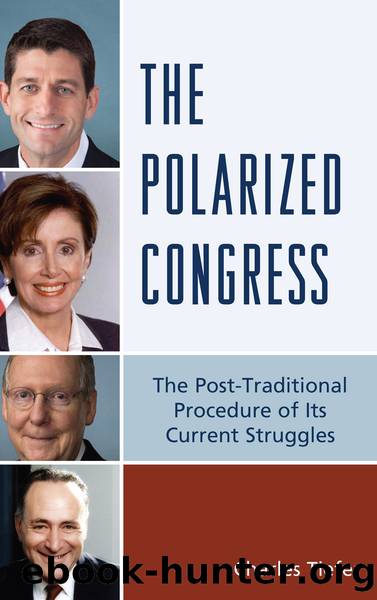The Polarized Congress by Tiefer Charles;

Author:Tiefer, Charles;
Language: eng
Format: epub
ISBN: 9780761867487
Publisher: UPA
For example, even a modest sportsmenâs bill faced âa free-flowing amendment process [that] would have forced red-state Democrats in tough reelection bids to take potentially tough votes on tweaking gun laws.â29 When the majority lacked the votes for cloture to cut off those amendments, the bill, âlike other popular bills before it, died under the weight of an amendment fight.â30
In another example, a controversial rider in the omnibus spending bill for fiscal year 2015 gave the green light for risky Wall Street derivatives at odds with the bank regulatory Dodd-Frank law. The bipartisan team of Senators Elizabeth Warren (D-MA) and David Vitter (R-LA) wanted a vote on striking the provision. However, the rider had bipartisan support, too, so the majority leader filled the tree (so there was no room for a motion to strike the Wall Street provision) while obtaining cloture.31 The provision became law.
Key: Combat Over Nongermane Amendments
In previous eras, the Senateâs acceptance of nongermane amendments had great significance. In the contemporary Senate, it still has much significance. âNongermane amendmentsâ has a technical ring. However, it simply expresses the startling reality that with a short minor bill on the floor, dealing with some minor subject, any Senator can offer a lengthy major amendment dealing with sprawling vital subjects. Senators may offer virtually anything and can amend anything else.
During the traditional period up into the 1990s, individual Senators, as well as the Senate minority party, derived considerable influence over the Senate agenda by their right to offer nongermane amendments. Roughly speaking, the Senate had three types of situations offering particular importance to nongermane amendments.32 The first was symbolic votes; for instance, those opposing whatever the President was doing that day. The second was amendments on omnibus vehicles, which might draw large numbers of amendments like a magnet. And, the third was amendments on serious bills with a strong possibility of enactment.
Each of these aspects remains meaningful in todayâs Senate. Symbolic votes on nongermane amendments still occur, but usually less spontaneously, by negotiation between the parties. The minority leader may find that he has enough rights from bargaining between the parties to anoint some âmessageâ nongermane amendments to receive a vote. However, the number is not infinite. Sometimes the majority leader may stop business, or find some way to limit amendments, rather than allow too many such âsymbolicâ votes.
In days past, when the committee system was stronger, majority leadership resistance to such âsymbolicâ votes derived in some measure from wanting to back up the crucial managers. The majority leadership thwarted symbolic votes to respect a chair whose committee had worked hard on a serious bill not to be diverted by sideshows. Senate committees still have high importance in todayâs Senate, but not as much as in the âgolden eraâ of chairs who were like barons.
To illustrate how symbolic votes on nongermane amendments may work, take this example: Frequently, it may occur to Senators to fight about some particular issue in the news of the day, using whatever bill happens at that moment to cross the floor as a vehicle for a symbolic vote on a nongermane amendment.
Download
This site does not store any files on its server. We only index and link to content provided by other sites. Please contact the content providers to delete copyright contents if any and email us, we'll remove relevant links or contents immediately.
The Secret History by Donna Tartt(18230)
The Social Justice Warrior Handbook by Lisa De Pasquale(11963)
Thirteen Reasons Why by Jay Asher(8472)
This Is How You Lose Her by Junot Diaz(6463)
Weapons of Math Destruction by Cathy O'Neil(5854)
Zero to One by Peter Thiel(5507)
Beartown by Fredrik Backman(5372)
The Myth of the Strong Leader by Archie Brown(5250)
The Fire Next Time by James Baldwin(5033)
How Democracies Die by Steven Levitsky & Daniel Ziblatt(4972)
Promise Me, Dad by Joe Biden(4916)
Stone's Rules by Roger Stone(4875)
100 Deadly Skills by Clint Emerson(4700)
A Higher Loyalty: Truth, Lies, and Leadership by James Comey(4566)
Rise and Kill First by Ronen Bergman(4554)
Secrecy World by Jake Bernstein(4407)
The David Icke Guide to the Global Conspiracy (and how to end it) by David Icke(4397)
The Farm by Tom Rob Smith(4332)
The Doomsday Machine by Daniel Ellsberg(4253)
